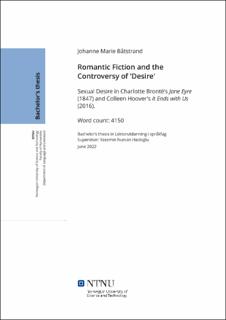| dc.contributor.advisor | Hacioglu, Yasemin Nurcan | |
| dc.contributor.author | Båtstrand, Johanne Marie | |
| dc.date.accessioned | 2022-07-05T17:21:26Z | |
| dc.date.available | 2022-07-05T17:21:26Z | |
| dc.date.issued | 2022 | |
| dc.identifier | no.ntnu:inspera:106680562:50010572 | |
| dc.identifier.uri | https://hdl.handle.net/11250/3002885 | |
| dc.description.abstract | Charlotte Brontës Jane Eyre og Colleen Hoovers It Ends with Us fremstiller kvinnelig begjær i populære romantiske romaner i sammenheng med politikk- og samfunnsdebatter relevant for deres samtid. I Jane Eyre er begjær sentral for Janes karakter, og er noe som påvirker både romanens fortelling og den forførende diskursen i forholdet til Jane og Mr. Rochester. Akademikere argumenterer at Brontës verk inneholder flere fremstillinger av det subjektive kvinnelige begjær enn annen viktorianske og gotiske litteratur, som bidrar i romanens populære realisme. Jane Eyre ga et nytt perspektiv på kvinnelig begjær, som var annerledes fra det mannlige synet som dominerte litteratur. Dette var i stor grad grunnet underrepresentasjonen av anerkjente og publiserte kvinnelige forfattere. I It Ends with Us er begjær sentral i fortellingen grunnet dens fremstilling av det nære forholdet mellom kjærlighet og vanskeligheten med å unnslippe et misbrukende forhold. Romanen fremstiller seksuelle relasjoner eksplisitt, noe flere kritikere har begynt å anerkjenne kraften av. Men, noen kritikere har argumentert at begjær i romaner har en negativ virkningskraft på sine lesere. Derimot, muliggjør fremstilling av kvinnelig begjær i romaner mobiliseringen av leseres bevissthet rundt virkelige diskusjoner og ulikheter når det er fremstilt sammen med samfunnsproblemer – for eksempel likhet mellom kjønn og vold i hjemmet. I konklusjon bidrar Jane Eyre og It Ends with Us i samfunnsdebatter ettersom de engasjerer lesere med kvinnelige perspektiver på samfunnsproblemer, samtidig som den mikser fortellingen med kvinners subjektive begjær. | |
| dc.description.abstract | Both Brontë’s Jane Eyre and Hoover’s It Ends with Us show female desire depicted in popular romantic novels connected to contemporary political and social debates. In Jane Eyre, desire is central to Jane’s character, which affects both the novel’s narrative and the seductive discourse of Jane and Mr. Rochester’s relationship. Scholars argue that Brontë’s work contains more depictions of the subjective female desire than other Victorian and gothic literature, contributing in the novel’s realism that is much of the reason for its popularity. Jane Eyre showed new perspectives to the female desire, which was greatly underrepresented in its contemporary as male views dominated literature because of the lack of recognized and published female authors. In It Ends with Us, desire is central within the novel’s narrative as it shows the close relation between love and struggles of leaving abusive relationships. The novel contains explicit descriptions of sexual relations, which more critics have started recognizing the power of. As the novels engage readers, it creates the opportunity for the creation of communities that share the love for the novels’ imaginary worlds. Both novels’ representation of desire are therefore reasons behind their popularity. Some critics have argued that desire in romantic fiction has a negative effect on readers, however, desire in romantic fiction can mobilize readers consciousness of real conflicts and inequalities when combined with depictions of societal problems – i.e. gender equality and domestic violence. In conclusion, Jane Eyre and It Ends with Us contribute in social debates, as they engage readers with female perspectives of societal problems mixed with a narrative imbedded with subjective female desire. | |
| dc.language | eng | |
| dc.publisher | NTNU | |
| dc.title | Romantic Fiction and the Controversy of 'Desire' | |
| dc.type | Bachelor thesis | |
